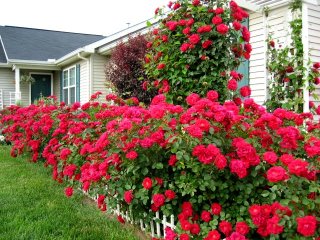Moisture crystals
If you haven't used these before take heed. They expand!!!
I was told that I could use these under plants planted in dry areas. The crystals hold a lot of water. So I planted some climbing annuals in a place that gets some water but not enough for healthy growth. So I put my trowel into the soil, worked it a little, made a fairly small hole, dropped a couple of tablespoons of the dry crystals into the bottom of the hole, and planted the morning glory plug on top. A couple of weeks later I was working in the area and noticed some of the plants had been pushed out of the ground. I tried to push them back in but the soil had a peculiar resistance. Instead of becoming packed, it pushed back at me. I remembered the crystals and dug into the soil to find it full of cubes of about half an inch in diameter. So I removed most of them, distributed them in the surrounding soil and settled the plant back into place.
Now I wonder how it is that the moisture gets to the plants if the roots of the plant are not in contact with the moisture cube. We made one of those neck coolers with some cubes in it and the fabric on the outside is never wet. So if the cubes don't wick moisture to cotton how do they give up its moisture to the soil? You would think that the roots must make contact with the cube, mustn't they?
A couple of weeks ago I read (but did not retain) information regarding the way that roots absorb water from the soil. It was rather complicated. I have been searching for it but cannot find it. However I have found info regarding how to apply the crystals (mined were bulk packaged and came without instructions). One is supposed to mix them uniformly into the soil before planting and keep some of that soil to backfill around the plant, leaving the top 1 - 2" without any crystals. It is preferable to allow the crystals to absorb moisture before mixing with the soil and the proportions are about 1.5 tsp to 1 gallon of soil.
Looks like I did everything wrong!!
This isn't what I read earlier, but nonetheless it is an explanation of how plant roots absorb water (from Wikipedia):
I was told that I could use these under plants planted in dry areas. The crystals hold a lot of water. So I planted some climbing annuals in a place that gets some water but not enough for healthy growth. So I put my trowel into the soil, worked it a little, made a fairly small hole, dropped a couple of tablespoons of the dry crystals into the bottom of the hole, and planted the morning glory plug on top. A couple of weeks later I was working in the area and noticed some of the plants had been pushed out of the ground. I tried to push them back in but the soil had a peculiar resistance. Instead of becoming packed, it pushed back at me. I remembered the crystals and dug into the soil to find it full of cubes of about half an inch in diameter. So I removed most of them, distributed them in the surrounding soil and settled the plant back into place.
Now I wonder how it is that the moisture gets to the plants if the roots of the plant are not in contact with the moisture cube. We made one of those neck coolers with some cubes in it and the fabric on the outside is never wet. So if the cubes don't wick moisture to cotton how do they give up its moisture to the soil? You would think that the roots must make contact with the cube, mustn't they?
A couple of weeks ago I read (but did not retain) information regarding the way that roots absorb water from the soil. It was rather complicated. I have been searching for it but cannot find it. However I have found info regarding how to apply the crystals (mined were bulk packaged and came without instructions). One is supposed to mix them uniformly into the soil before planting and keep some of that soil to backfill around the plant, leaving the top 1 - 2" without any crystals. It is preferable to allow the crystals to absorb moisture before mixing with the soil and the proportions are about 1.5 tsp to 1 gallon of soil.
Looks like I did everything wrong!!
This isn't what I read earlier, but nonetheless it is an explanation of how plant roots absorb water (from Wikipedia):
"Osmotic pressure or turgor (also called turgor pressure) is the pressure produced by a solution in a space that is enclosed by a differentially permeable membrane.No wonder I didn't retain it the first time I read about it....
When a biological cell is in a hypotonic environment (the cell interior contains a lower concentration of water than its exterior), water flows across the cell membrane into the cell, causing it to expand. The membrane (or, in plant cells, the cell wall) restricts the expansion, which causes an increase in pressure. The resulting pressure is called turgor. This pressure is what prevents more water from flowing into the cell, thus creating a pressure equilibrium between water flowing down the concentration gradient and the taut membrane pushing back. In this example, the equilibrium prevents the cell from ever becoming isotonic to its environment. Cells not adapted to hypotonic environments, with the flow of water into them but no strong membrane or cell wall, will burst. The osmotic pressure π of a dilute solution can be calculated using the formula
where
M is the molarity
R is the gas constant
T is the thermodynamic temperature (formerly called absolute temperature)
Note the similarity of the above formula to the ideal gas law, and also that osmotic pressure is not dependent on particle charge."



